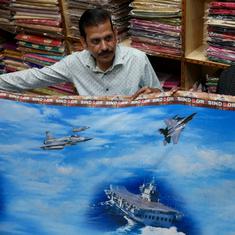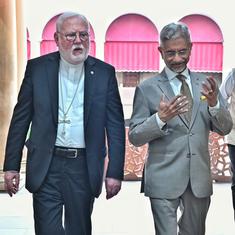When India and Pakistan clashed in May, both sides rushed to control the narrative. Pakistan claimed it had shot down five Indian fighter jets, including three Rafales, during Operation Sindoor.
These claims were somewhat supported by international media: Reuters and CNN reported the loss of at least one Rafale based on US and French intelligence, while BBC Verify authenticated wreckage found in Bathinda, Punjab.
Yet India has not come forward with a clear account of its losses. Instead, military officials issued vague acknowledgments, offering no confirmed numbers.
This deliberate ambiguity allowed Pakistan to shape the story. Its narrative went largely unchallenged, strengthening its symbolic standing in the region. India’s silence created a vacuum filled with speculation: was it one Rafale, two or three?
The refusal to clarify did more than just cede ground in the information war, it undermined public understanding, distorted strategic assessment and potentially impaired military learning.
In an age of satellite surveillance, real-time battlefield imagery and open-source intelligence, it is nearly impossible to hide the facts of war. Yet many states continue to try. Governments that initiate or escalate military conflicts often attempt to downplay their own losses. From Russia in Ukraine to Israel in its conflict with Iran, and India in its long-running tensions with Pakistan, the instinct to control the optics remains strong.
Leaders seek to maintain domestic morale, project strength, and shield themselves from political fallout. But the consequences of this approach can be grave and long-lasting.
Ukraine war
Russia’s war in Ukraine is perhaps the most striking example of this pattern in recent years. From the outset of the full-scale invasion in February 2022, the Kremlin insisted that operations were proceeding according to plan. It described the war as a “special military operation”, downplayed Ukrainian resistance and refused to disclose accurate casualty figures. Visual evidence of destroyed Russian columns, abandoned equipment and mounting losses was dismissed or ignored.
But the truth could not be contained. As the war dragged on, independent estimates of Russian casualties soared into the thousands. The rapid mobilisation of undertrained reservists and a rising tide of online obituaries exposed the scale of the human cost.
Soldiers’ families began to question the official version of events. Returning veterans described the chaos at the front, poor logistics, dysfunctional command, and ill-prepared troops. Despite tight media controls, the story that Russia told itself began to fracture.
Israel, too, has fallen into the trap of narrative control. When Iran launched a massive drone and missile barrage in June in retaliation for the bombing of its purported nuclear sites, Israeli officials focused on success stories: most of the missiles were intercepted, the air defense systems performed admirably, and coordination with international partners was strong.
But independent reporting suggested a less tidy picture. Sensitive military and civilian targets were hit and casualties were higher than initially admitted. The government’s insistence on projecting confidence may have soothed domestic audiences, but it glossed over critical vulnerabilities.
India’s own approach during its most recent standoff with Pakistan followed the same script. After cross-border strikes and retaliatory exchanges in Jammu and Kashmir, Indian officials declared operational success. There was no public acknowledgment of damage to military infrastructure or personnel. The messaging focused on precision, deterrence, and strategic control.
Yet Pakistani sources and open-source analysts told a more complex story, one in which both countries suffered losses and neither gained a clear upper hand. India’s unwillingness to confront the costs of conflict raised questions about whether its armed forces could conduct the kind of honest, internal review required to improve performance in future engagements.
This instinct to conceal or reframe battlefield setbacks is not new. During the Vietnam War, the United States military issued daily briefings that claimed progress, even as the situation on the ground deteriorated. It was not until the Tet Offensive in 1968, a sweeping assault by North Vietnamese forces, that the disconnect between rhetoric and reality became undeniable. The credibility gap destroyed public trust and forced a fundamental reassessment of the war effort.
Israel’s experience in the 1973 Yom Kippur War offers another cautionary tale. Caught by surprise, its forces suffered heavy casualties and early territorial losses. The government initially presented a narrative of eventual triumph, but domestic outrage led to the creation of the Agranat Commission. The commission’s findings exposed deep flaws in Israeli intelligence and military assumptions. That painful reckoning was crucial in driving reforms that strengthened the Israeli Defense Forces for decades to come.
India’s 1962 war with China remains a sobering example of the costs of denial. After an embarrassing defeat in the Himalayas, the Indian establishment downplayed the extent of its failures. Reports detailing logistical breakdowns and flawed strategy were buried. As a result, institutional learning was delayed. Many of the same weaknesses reemerged in later conflicts with China.
At the heart of this issue is a simple truth: military organisations cannot grow stronger unless they are willing to learn from failure. Effective warfighting depends on accurate self-assessment, identifying what went wrong, where systems failed and how to adapt.
Hiding losses or rewriting history short-circuits that process. It leads to inflated perceptions of capability, false confidence, and strategic stagnation.
Undermining democracy
The political consequences are equally corrosive. In democratic societies, concealing military losses weakens civilian control and erodes trust. Citizens deserve an honest account of how conflicts are fought in their name. In authoritarian regimes, the lack of public scrutiny can entrench bad doctrine and suppress internal dissent, leaving armed forces vulnerable to repeat mistakes.
Even from a purely strategic standpoint, pretending that nothing went wrong can backfire. Adversaries are not fooled. They analyse wreckage, monitor communications, and track deployments. When a state’s public narrative is at odds with observable facts, it loses credibility – and credibility is often a form of deterrence.
Worse still, if leaders believe their own propaganda, they may commit to further escalations without fully understanding the risks.
There is a better path. While operational secrecy during wartime is necessary, states must embrace transparency once the guns fall silent. This means creating independent review mechanisms, listening to returning pilots and frontline soldiers, declassifying key findings and cultivating a culture of candour within the military. The countries that emerge stronger from war are those that treat failure not as a political liability but as a catalyst for learning.
War tests not only the strength of weapons, but the resilience of institutions. The ability to confront mistakes, learn from them and adapt – these are the marks of a mature and capable state. For India facing a volatile neighborhood, for Israel confronting multiple fronts, and for Russia locked in a protracted conflict, the illusion of invincibility is not a strength. It is a trap. The path to real security lies in truth, not denial.
Ashok Swain is a professor of peace and conflict research at Uppsala University, Sweden.










